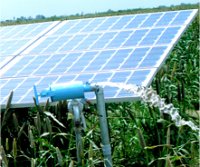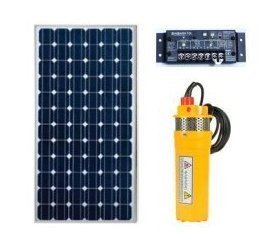|
|
|
Useing Solar Power for Pumping Water
|
 If you live in a remote area and have a watering application like irrigation or livestock watering, a solar powered water pump system can be a solution that's both reliable and economical. Our guide covers a few basics about powered pumping systems, including array only, a battery backup setup, and water storage.
If you live in a remote area and have a watering application like irrigation or livestock watering, a solar powered water pump system can be a solution that's both reliable and economical. Our guide covers a few basics about powered pumping systems, including array only, a battery backup setup, and water storage.
What Types of Solar Pumps are Available
Solar water pumps are available in two basic designs, they are submersible and surface. A submersible water pump is usually installed down into a well. A submersible pump can also be used in a free standing water source such as a stream, pond or lake.
Surface Pumps
Surface pumps are used above the source's water level. Surface pumps draw water up from shallow sources like a pond or creek bed.
Submersible Pumps
A submersible water pump pushes water up to a storage tank. Some models can pump water out of deep wells at a depth of hundreds of feet or more. Most models have built-in filters allowing them to operate with water that has relatively high levels of silt.
 Solar Pumping Systems
Solar Pumping Systems
There are three common solar powered water pumping systems being used today in irrigation and for livestock watering on farms and ranches.
Solar Array Direct (no batteries) with Elevated Water Storage
The most efficient solar water pumping system is solar direct without any backup batteries. This type of solar powered water pumping solution operates by connecting a DC powered submersible pump directly to the solar array. Usually a controller or linear current booster is also wired between the solar array and the solar pump. The booster works to optimize and regulate array voltage and current to maximize the amount of water pumped during varying sunlight.
During the day when the sun is shining, the pump moves water into a storage tank located above the water's point of use. Gravity is then used to feed water down into livestock watering bins as needed. This type of system does not have a battery reserve so the pump will only pump water into the storage tank during daylight hours. All water needed for a 24 hour period must be pumped during the day. The water storage tank should be sized to hold at least 5 days of water reserve to cover consecutive low sun days such as during bad weather.
|
|
|



